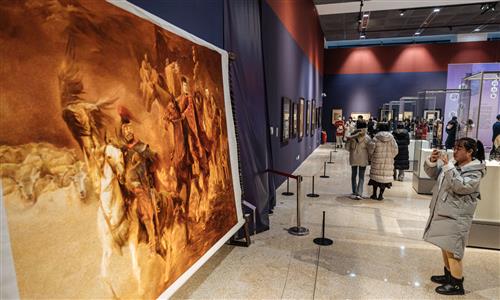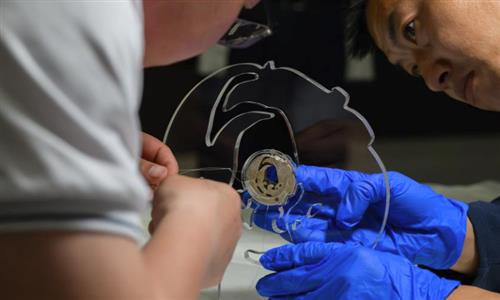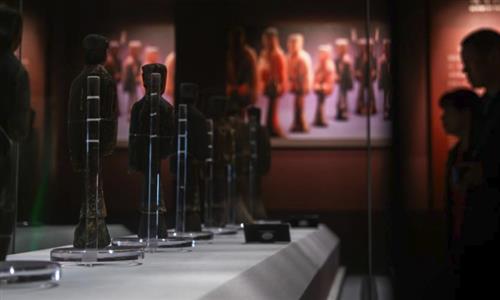ARTS / ART
Suzhou Museum displays novel architecture, exquisite relics
Tradition and innovation
On Wednesday, the list of first-grade national museums was released in China, featuring 204 distinguished institutions. Among them stands the Suzhou Museum in East China's Jiangsu Province, which has been enlisted as a first-class museum since 2008.
The Suzhou Museum, distinguished by its innovative architectural style, was designed by the world-renowned Chinese-American architect Ieoh Ming Pei for his ancestral home.
With a collection of more than 30,000 historical relics spread across 10,700 square meters, the museum comprises central, east and west halls connected by corridors. The first and second floors consist of four basic exhibitions, while the underground floor houses a special exhibition hall, a theater, and a lecture hall.
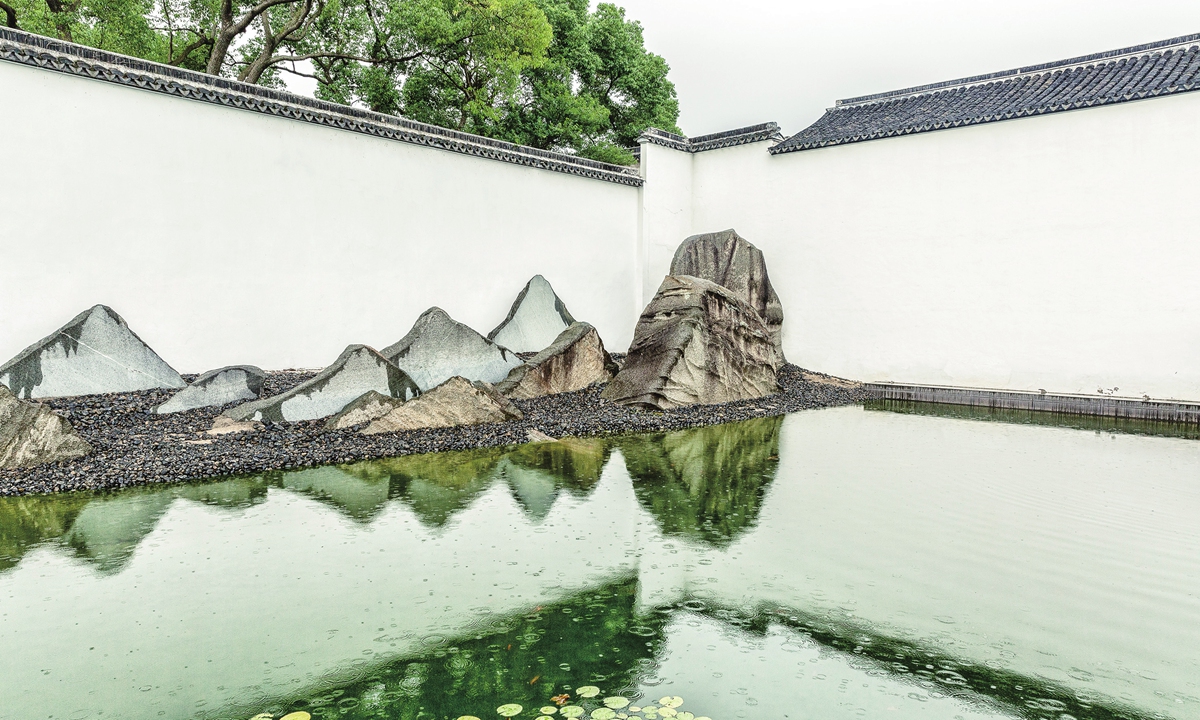
Built in October 2006, the Suzhou Museum is a structure that perfectly integrates both traditional and modern architectural elements. The building features white walls and a grey-tiled rooftop, harmonizing well with the historical and cultural neighborhood with the famous Humble Administrator's Garden nearby.
Through the frames of windows of different shapes, visitors can peek at the natural scenery artfully arranged by well-trimmed trees and enjoy the integration of the original natural environment and the structure's artificial scenery.
Right outside the exhibition halls, a zigzagging path leads visitors through a typical Suzhou courtyard, which features a pond and a pavilion.
Interestingly, the courtyard also offers a fascinating trompe l'oeil experience thanks to the clever positioning of rocks on the pebbles by the pond and against the backdrop of the northern white wall, looking like a real Chinese landscape painting.
On top of these classical elements, the museum also features modern architectural materials like glass, granite and steel and concrete that replace slanting clay shingles and wooden beams, respectively. Particularly, visitors are attracted at the first sight by its geometric shapes such as rhombuses, hexagons and squares of the exhibition building.
What is more worth mentioning is that Pei's core concept for the building lies in his masterful use of light. Above the corridors, metal sunscreen strips and traditional wooden materials filter sunlight, making visitors feel like walking under the bamboo shade. And the sunlight through windows can also shift radiating angles with the change of time, producing different visual effects.
The interplay between soft natural elements and hard architectural materials add to the museum's allure, creating a harmonious balance between tradition and innovation and an architectural wonder.
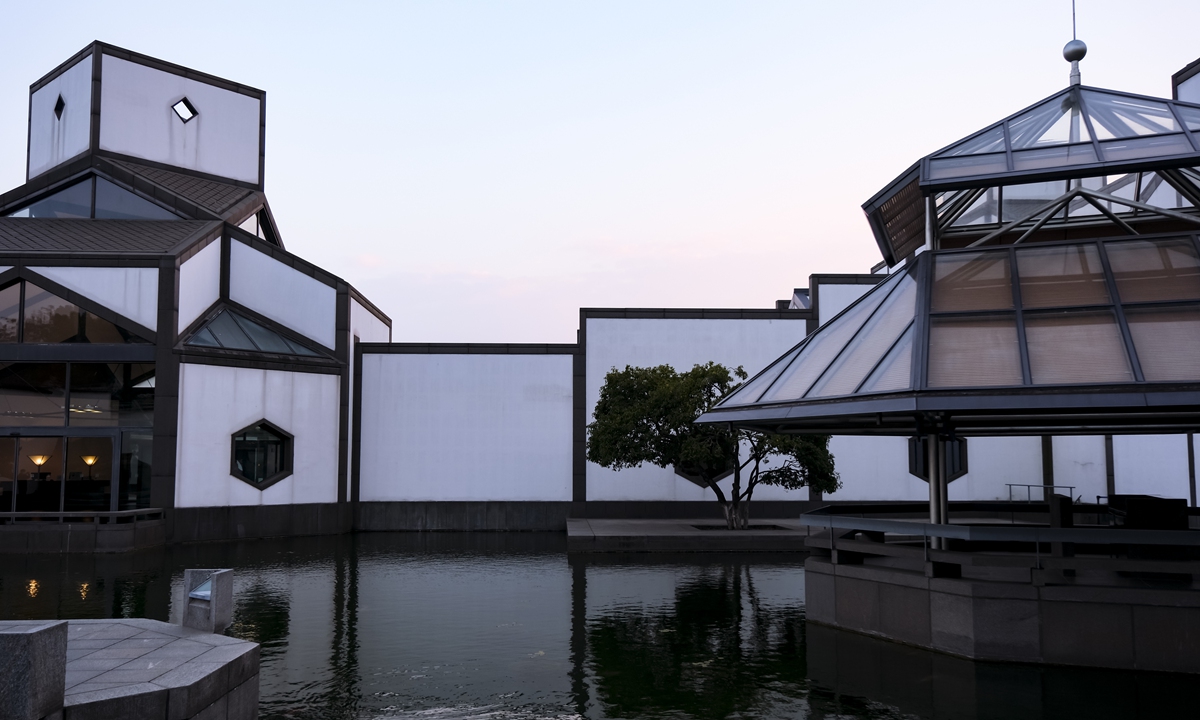
Suzhou boasts a history of more than 4,000 years and a rich cultural heritage. According to historical records, Suzhou was established as the capital of the State of Wu in 524 BC. Since then, it has maintained its identity as one of China's famous historical cities.
The museum's collection spans four sections, including bronze wares, jade wares, pottery, porcelain, paintings and calligraphy, and silk garments excavated from the archaeological sites of the surrounding region.
The first section consists of jade wares, bronze wares, pottery, porcelain, which reflect the cultural advancement of Suzhou in ancient times. Small Buddhist pagodas take up the second section with national-level relics. In the third section, bamboo and wood carvings, silk garments, furniture made of precious wooden materials in the study amaze visitors with their exquisite craftsmanship and elegant style.
As one of the cradles of Chinese civilizations, Suzhou is also known for numerous literati and artists. The fourth section houses the masterpieces of the Wu School of the Ming Dynasty, featuring landscape paintings, and those of the Yangzhou School, another city close to Suzhou known for its flower and bamboo paintings.
The most precious treasures in the museum include a national treasure, the bronze sword of Fuchai, king of the State of Wu in 495 BC, a ceramic bowl in the shape of a lotus flower from the Five Dynasties Period (907-960) and the Pearl Pillar of the Buddhist Shrine from the Song Dynasty (960-1279) unearthed from one of the two Buddhist temples in Suzhou.
Among them, the sword made more than 2,000 years ago draws a lot of people's attention. It is particularly well known for its two-step casting technique. First, the alloy of bronze and a higher amount of tin was employed to form its handle, then bronze was used to make its body, and finally the two parts were linked together, so the sword is sharp and firm. The sword is also marvelous for the refined inscriptions engraved on it, recording the name of the maker, its function, and the time of its making. It represents the advanced weapon-making craftsmanship in ancient China and unique aesthetics in the State of Wu with profound historical and cultural significance.
Today, the Suzhou Museum ranks among the city's top tourist attractions. Among tourists, a saying goes: "Without visiting the Suzhou Museum, you have not been to Suzhou." Embracing this sentiment, young people increasingly view museums as "universities" or knowledge powerhouses that can help them learn more about a city and its culture.
While strolling along Suzhou Museum, visitors can get an additional treat. Bai, a university student, told the Global Times, "I've never seen a pond inside a museum. It looks like a garden. This museum may not look so imposing, but when I walk through it I feel relaxed, as if wandering in an art gallery." Indeed the Suzhou Museum is worth exploring.
The Suzhou Museum, distinguished by its innovative architectural style, was designed by the world-renowned Chinese-American architect Ieoh Ming Pei for his ancestral home.
With a collection of more than 30,000 historical relics spread across 10,700 square meters, the museum comprises central, east and west halls connected by corridors. The first and second floors consist of four basic exhibitions, while the underground floor houses a special exhibition hall, a theater, and a lecture hall.

The trompe l'oeil painting in the courtyard of the Suzhou Museum Photo: VCG
A unique designBuilt in October 2006, the Suzhou Museum is a structure that perfectly integrates both traditional and modern architectural elements. The building features white walls and a grey-tiled rooftop, harmonizing well with the historical and cultural neighborhood with the famous Humble Administrator's Garden nearby.
Through the frames of windows of different shapes, visitors can peek at the natural scenery artfully arranged by well-trimmed trees and enjoy the integration of the original natural environment and the structure's artificial scenery.
Right outside the exhibition halls, a zigzagging path leads visitors through a typical Suzhou courtyard, which features a pond and a pavilion.
Interestingly, the courtyard also offers a fascinating trompe l'oeil experience thanks to the clever positioning of rocks on the pebbles by the pond and against the backdrop of the northern white wall, looking like a real Chinese landscape painting.
On top of these classical elements, the museum also features modern architectural materials like glass, granite and steel and concrete that replace slanting clay shingles and wooden beams, respectively. Particularly, visitors are attracted at the first sight by its geometric shapes such as rhombuses, hexagons and squares of the exhibition building.
What is more worth mentioning is that Pei's core concept for the building lies in his masterful use of light. Above the corridors, metal sunscreen strips and traditional wooden materials filter sunlight, making visitors feel like walking under the bamboo shade. And the sunlight through windows can also shift radiating angles with the change of time, producing different visual effects.
The interplay between soft natural elements and hard architectural materials add to the museum's allure, creating a harmonious balance between tradition and innovation and an architectural wonder.

A general view of the Suzhou Museum Photo: VCG
'Art gallery'Suzhou boasts a history of more than 4,000 years and a rich cultural heritage. According to historical records, Suzhou was established as the capital of the State of Wu in 524 BC. Since then, it has maintained its identity as one of China's famous historical cities.
The museum's collection spans four sections, including bronze wares, jade wares, pottery, porcelain, paintings and calligraphy, and silk garments excavated from the archaeological sites of the surrounding region.
The first section consists of jade wares, bronze wares, pottery, porcelain, which reflect the cultural advancement of Suzhou in ancient times. Small Buddhist pagodas take up the second section with national-level relics. In the third section, bamboo and wood carvings, silk garments, furniture made of precious wooden materials in the study amaze visitors with their exquisite craftsmanship and elegant style.
As one of the cradles of Chinese civilizations, Suzhou is also known for numerous literati and artists. The fourth section houses the masterpieces of the Wu School of the Ming Dynasty, featuring landscape paintings, and those of the Yangzhou School, another city close to Suzhou known for its flower and bamboo paintings.
The most precious treasures in the museum include a national treasure, the bronze sword of Fuchai, king of the State of Wu in 495 BC, a ceramic bowl in the shape of a lotus flower from the Five Dynasties Period (907-960) and the Pearl Pillar of the Buddhist Shrine from the Song Dynasty (960-1279) unearthed from one of the two Buddhist temples in Suzhou.
Among them, the sword made more than 2,000 years ago draws a lot of people's attention. It is particularly well known for its two-step casting technique. First, the alloy of bronze and a higher amount of tin was employed to form its handle, then bronze was used to make its body, and finally the two parts were linked together, so the sword is sharp and firm. The sword is also marvelous for the refined inscriptions engraved on it, recording the name of the maker, its function, and the time of its making. It represents the advanced weapon-making craftsmanship in ancient China and unique aesthetics in the State of Wu with profound historical and cultural significance.
Today, the Suzhou Museum ranks among the city's top tourist attractions. Among tourists, a saying goes: "Without visiting the Suzhou Museum, you have not been to Suzhou." Embracing this sentiment, young people increasingly view museums as "universities" or knowledge powerhouses that can help them learn more about a city and its culture.
While strolling along Suzhou Museum, visitors can get an additional treat. Bai, a university student, told the Global Times, "I've never seen a pond inside a museum. It looks like a garden. This museum may not look so imposing, but when I walk through it I feel relaxed, as if wandering in an art gallery." Indeed the Suzhou Museum is worth exploring.

